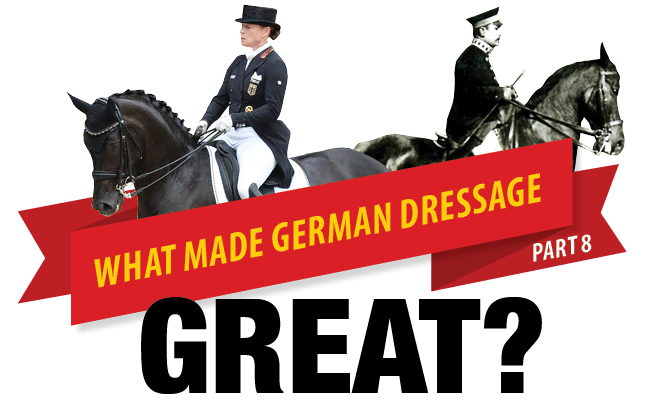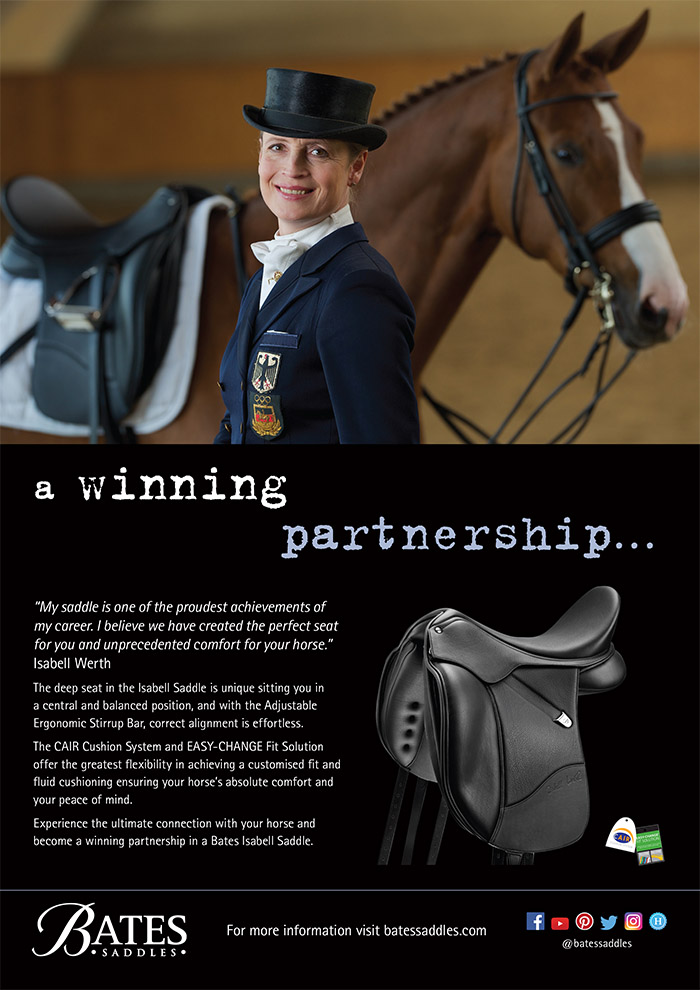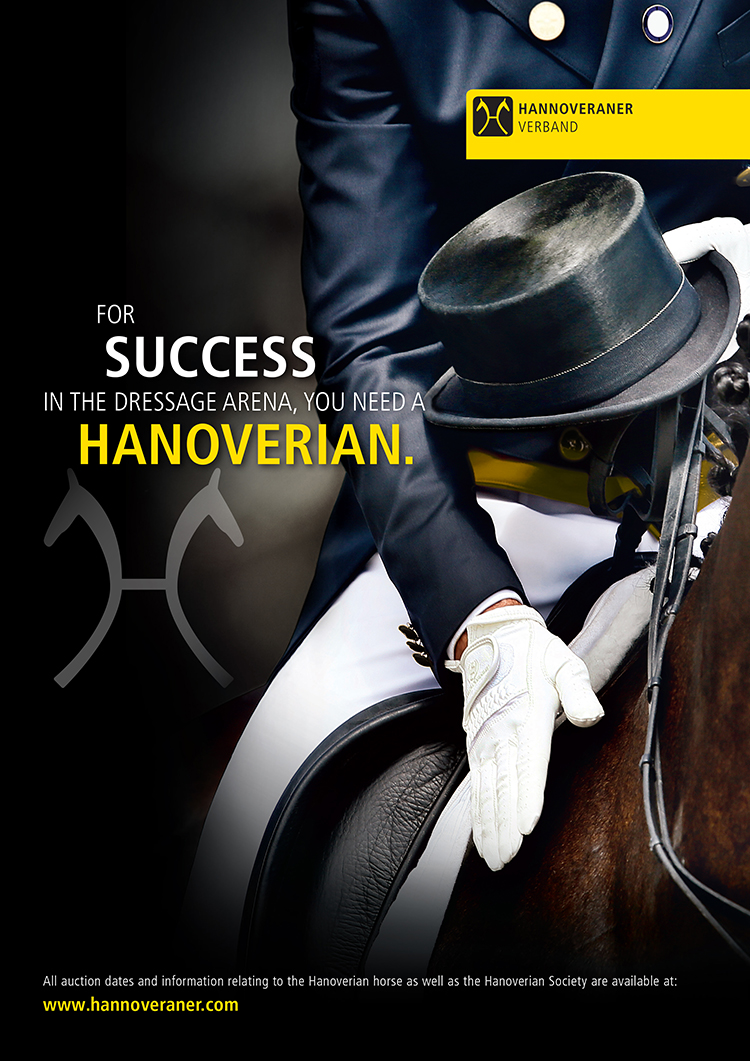Missed the earlier episodes? Here they are: Part 1 – Part 2 – Part 3 – Part 4–Part 5– Part 6– Part 7
It’s happened, we’ve actually come to the end of our series – but not before we talk with Christoph Hess, Dietrich Plewa, Monica Theodorescu and Hubertus Schmidt…
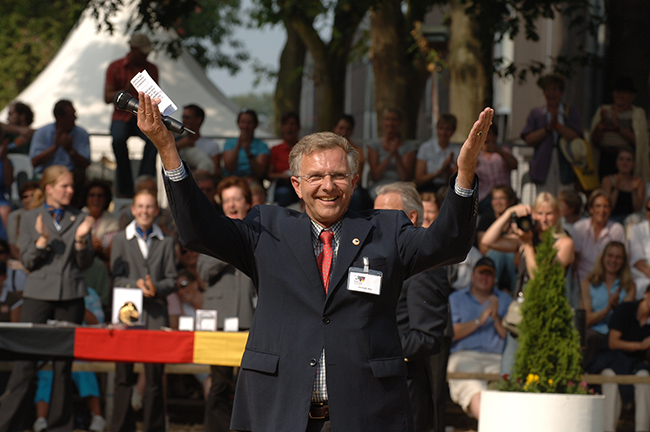
Christoph Hess – Equestrian Education
The German FN headquarters in Warendorf was home for many years to one of the more influential educators and guardians of the classical principles in our time, Christoph Hess, who worked with the German National Equestrian Federation and for the German Olympic Committee in the education department at Warendorf from 1978 until his retirement in 2016. During that time he travelled the world as an international judge in dressage and eventing, and was often called upon as a commentator. Now he travels the world even more frequently spreading the message of correct, progressive dressage.
I asked him: What made German dressage great?
“An easy question, but one that is very difficult to answer. One step is that you need the right horses. German breeding provides good horses for the riders to select from.”
“The second step that I think is very important is the system. We have many good riders, not all riders are good, but many are good thanks to the system. When I say ‘system’ I mean two things. First of all we have a clear system in the theory, our Principles of Riding. Then we have a good system to train trainers. To become a trainer you need to take special steps, special badges, and then if they want to become professionals, they have to stay in a professional stable for at least two or three years and then they have to work in a professional stable and qualify before they are allowed to train young trainers.”
How many people go through the system every year?
“I think fifty to eighty. In the last years, a little bit less, I would say fifty go through to the highest level, at the lower level, approximately two hundred. Then we have one thousand, more or less, who do take part as an amateur, they have often another profession, and learn to train as a hobby. This system is good because it means we have a lot of good, properly trained trainers.”
“The third thing is a little bit the mentality, that people in Germany really train intensively, which is very important. Not to train one day, and then to sleep two days – to train every day with good trainers. Then we have a very good system of competitions, where they can prove their own horses, and also look at what other riders are doing, to see others, helps a lot.”
“We have a very good selection process, especially for Young Riders to come to the German Championships, later the Europeans. Then we have the same system for Young Horses – for example the Nürnberger Burg-Pokal to bring younger horses from Prix St Georg to Grand Prix. This system is a very good way of bringing the right horses and the right riders together.”
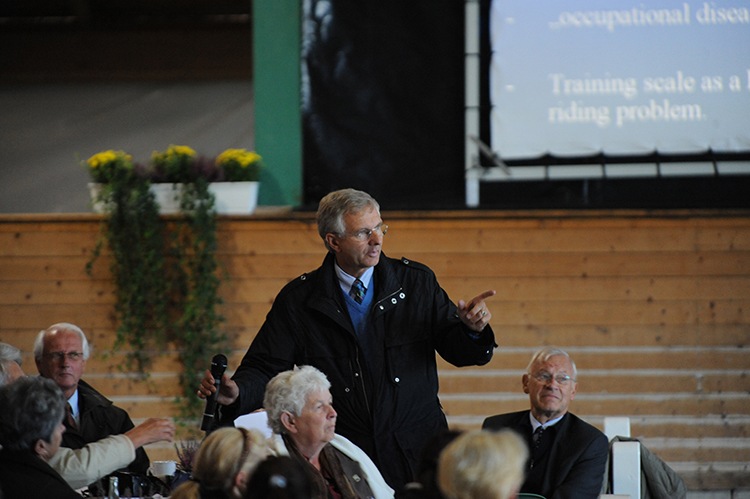
What amazes me is that in Germany it is not so easy to keep a horse. In Australia, you can put a horse out in a little paddock and because of the climate, he can live there all year – in Germany it is much more expensive because he needs to be stabled a lot of the time… but even in 1901, Fillis said that the German civilian population were the best-educated riders in the world. Where does this culture of the horse come from?
“Very much from the cavalry very early. Then we have this system of riders’ clubs. At the end of the day, I think it is very important that riders don’t just ride in the back yard by themselves, that they ride together and see how other riders are riding. You learn very much with your eyes.”
And is that part of the system thanks to Gustav Rau?
“Exactly, Gustav Rau. Very many riding clubs started before the Second World War, many of the clubs are nearly one hundred years old. Near Warendorf we have one club, where Reiner Klimke started, and this club is still very popular and still brings young riders into the sport, sometimes international sport.”
You talk about the cavalry, but the French had cavalry schools, but they became bogged down in the mind-boggling complexities of Baucher, while you had, with Steinbrecht, a relatively simple system that was friendly to the horse and rider…
“This is absolutely right. When you look to Saumur, it’s a little bit trick and circus riding – we in Germany with the influence of Steinbrecht, what we do is gymnastics for the horse. It is a big gymnastic process, and the gymnastic is very close to the nature of the horse. We look to the nature. What do horses like? They like to run, it is important to remember the horse is a flight animal, and that is part of our training system. The second thing is that the horse is a herd animal, and that is important for working with young horses. The third thing is that horses are animals that accept hierarchy, and it is important that the rider has to explain to the horse, what to do. It is very important to have these three things in your mind when you school a horse.”
When I look at the German scene, what strikes me is the number of great trainers. When we look for instance at Otto Lörke and his influence – Schultheis, Kuckluck, Günter – but there are many others like Richard Wätjen…
“You are right. But if we look at the riders we saw today here at Frankfurt, Matthais Bouton, a rider who has learned for years with Isabel (Werth). He had two horses here today. The second was Marcus Hermes, he was a long time with Hubertus Schmidt. The good riders have always been in very good places to learn.”
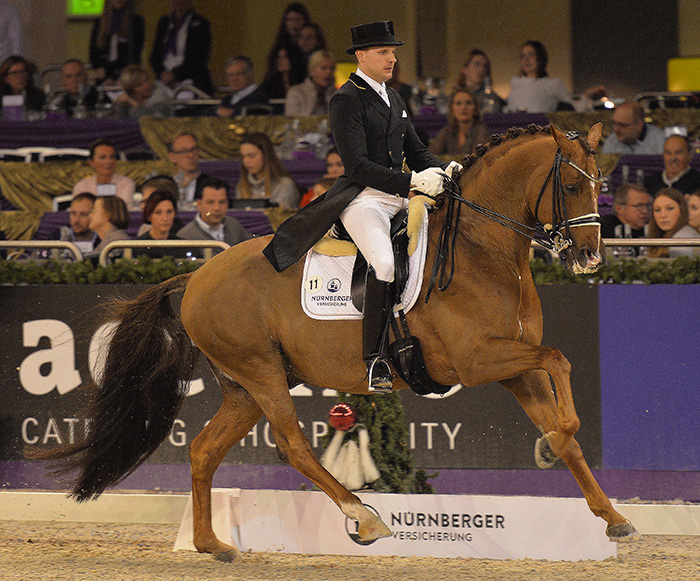
Matthais Bouton – good riders find good places to learn
But they do it for a long time, you look at someone like Marco Kutscher, a brilliant rider, but he spends fifteen years with Ludger Beerbaum before he goes out on his own. Our riders come to Germany, spend a month somewhere not very good, and go back home and they are professionals…
“Absolutely. You have to take time to learn how to deal with all different kinds of horses, different ages, and also how to train other riders with their horses. When you look to the good riders in the world, all of them spent years at places where the top rider was really top.”
Will German dressage continue to be great?
“I am quite optimistic. We have so many riders and horse, I wouldn’t say it was easy but it is not so difficult for Monica (Theodorescu) as our National Coach, and Jonny Hilberath, to select the right riders for the WEG or the Olympic Games. I think for all the equestrian disciplines, we should look at the sport of golf. I asked one of the golf professionals, what is the secret and he said, Christoph, system and consequence. And I said that’s 100% the same for us as well. You have to understand the system, that’s a red line for all horses, all riders, and then you have to do it very consistently. Not today this, and tomorrow that, and changing every day, no – system, and do it consistently. To ride each corner as a quarter of a circle, when you do this every time then you come to a higher national or international level.”
The Trainers – Monica Theodorescu
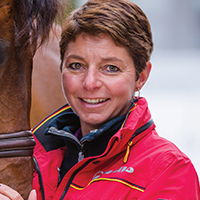
Back at the DOKR, we find German Team Coach, Monica Theodorescu. Monica has moved to the FN headquarters at Warendorf from Gestüt Lindenhof, the large dressage training centre established by her parents just down the road in Sassenberg, and is enjoying the freedom of just renting stables at the DOKR for her and her bereiter to use.
Well as relaxed as someone can be, who has to continually travel from one end of Germany to the other, looking at horses and riders, not to mention the busy international competition circuit. But Monica wears pressure lightly, she even says she is enjoying the job…
We had just travelled from the Frankfurt Horse Show where we saw in action another element in the German dressage mix, an informed and educated (large) crowd of spectators.
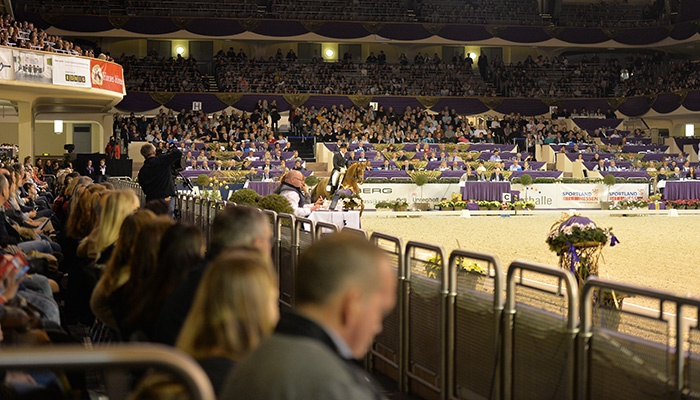
Monica explains: “It’s unbelievable. It grows every year, Frankfurt is an absolute highlight for dressage for the audience. The Nürnberger final for the past five or six years was sold out. People make it like a little Christmas holiday, going to Frankfurt from their riding clubs, and they meet at the show. They go to the Final and to the Christmas Market, in the city of Frankfurt, and meet other people from the sport, just a nice Christmas weekend including the final. But now there is also the Louisdor final, and that makes me very happy – starting at a quarter to nine on a Sunday morning and at nine thirty the hall is full! Sunday morning in the winter with horrible weather outside… For us in dressage this is very special, you can’t say, we need the jumpers to fill the arena, and early in the morning put on some dressage that nobody wants to see. It’s not the case any more.”
Is this something new, the growth of a dressage audience?
“I think it has been growing in the past few years. For sure it is to do with the Freestyle, all the World Cup indoor freestyles are more or less sold out. Slowly we get a better place on the timetable, we were helped by the FEI which made a rule that the Freestyle should be at a good time on the timetable where people can see it, not at eight o’clock on Sunday morning.”
But there was no sugar coating for the Burg-Pokal, it was just a very serious introduction to FEI level for younger horses, and the audience really understood what they were seeing…
“They were totally involved, they loved it.”
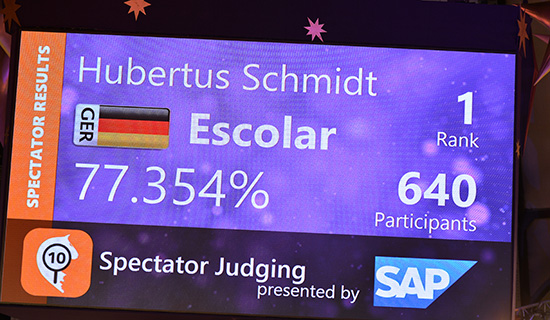
And judged well! (At this particular show the audience seemed to get it right more often than the ground jury, when their scores went up on the scoreboard next to the judges)
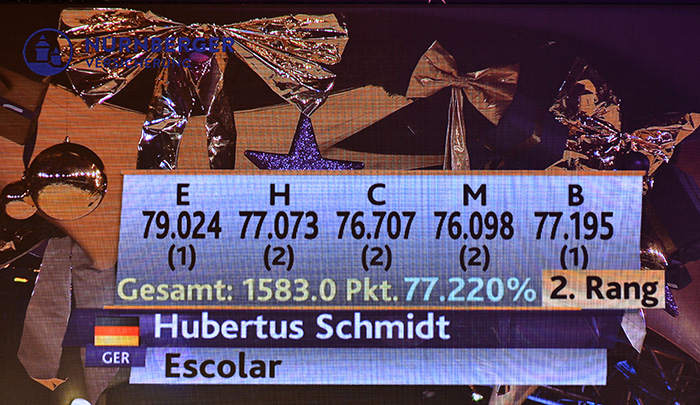
“They are really horse people. The regional amateur riders, they don’t have any indoor shows now, specially not just before Christmas, so they come with a bus to Frankfurt from all over Germany, and it grows every year because it is high level and super interesting. Breeders like it, people from riding clubs, and they involve them in many ways – on Wednesday afternoon, Thursday morning at Frankfurt, they had a team competition for the regional riders – the instructor and his pupils. One is doing a Prix St Georges, or a Senior Rider class, one is doing an L class for the Juniors, one is doing a Young Rider class, together with a Pony Rider. They get marked as a team. So you have all these regional riders there, and their families…”
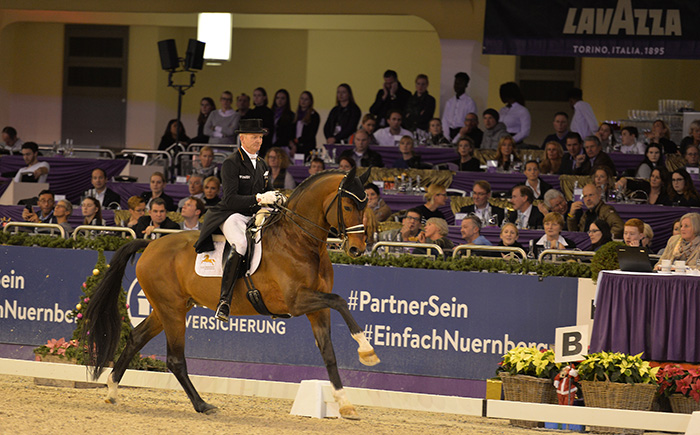
Was it always like this – when your father came to Germany in 1956, was dressage like this?
“It was for sure not like that. There were not that many shows. In the sixties, seventies, it was growing slowly but we always had a high level of dressage. They did well then, maybe not compared to our times, but at that time with the material they had, and the knowledge and the training they had, they were also winning at the Championships.”
“It was also through the breeding, which you know how very selective it has become. This is a big… I don’t like the word ‘industry’ but it is a big…”
Industry…
“Industry, and there are many many people involved.”
But there is also a culture where people want to go to a trainer – in our country riders think, oh but I go once a month to the trainer…
“No, no, no. This is our attitude, it happens in other sports as well. Especially in the past ten years, a lot has been done with training in all the sports. I think we like to think that we are a very disciplined people. We like structures… We go to trainers monthly, or weekly, or daily and have our daily structure. Not, I’ll see how the weather is, and maybe I’ll take the horse out, or not. We ride it every day. We don’t ride the same every day, but we don’t just take a day off. Today we have to do this, then this, then this. This is our mentality.”
The other thing is the number of great trainers – from Lörke to Schultheis to Zeilinger, to Kuckluck to Rehbein, to Peilicke, I can think of no other country that has produced anything like the number of great trainers… Where does that come from?
“It’s a good question. A lot, for sure, comes from the Cavalry. Those were the first trainers, like Lörke and all the old masters who also wrote books, they came from the Cavalry. They did nothing else than train horses, make them rideable and obedient. Otto Lörke was making the horses for the Kaiser who had only one arm, so he had to ride with one hand – so the horse had to be very supple, well trained and obedient. Many of them wrote books, or notes, and our Principles comes from the manual for the Army, and this is our base.”
“It is all set down in our Principles, the first book is just about young horses and riding, in the next it is specialised for jumping, eventing and dressage. The first is how to work a horse, how to lunge a horse, the gaits… it has everything. This is from the old masters in the army, who wrote down how a horse should be, and move, and be treated.”
“And this book has been re-done, updated, every twenty, forty years, it has been adapted to keep up with the times…”
But the horses have changed also, even when you were competing, no one was breeding for dressage – if the horse couldn’t jump…
“Then maybe he was a dressage horse.”
You must have noticed how much the horses have changed…
“Of course, just turn around (the room we are sitting in has large windows looking over an indoor school where one of Monica’s young riders, Bianca Norwag is working her horse) there is a modern four-year-old being worked. This is what the riders have to work with today – uphill by nature, great movement.”
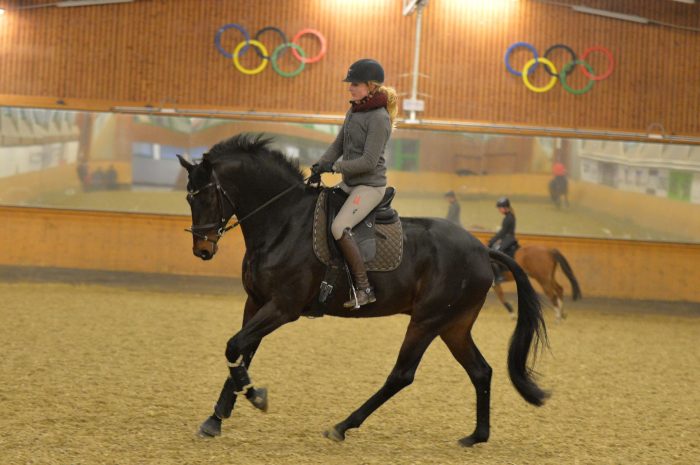
Does that make your work easier?
“Yes and no. The horses now in their conformation and their gaits probably have more quality than the horses in former times but then you have to be careful because they offer a lot these young horses – but still, I think the training has to be correct and step by step. The horses may have changed, but it is still a horse, four legs, a head and a tail, so the guidelines on how to treat and work horses don’t change because they have a better quality.”
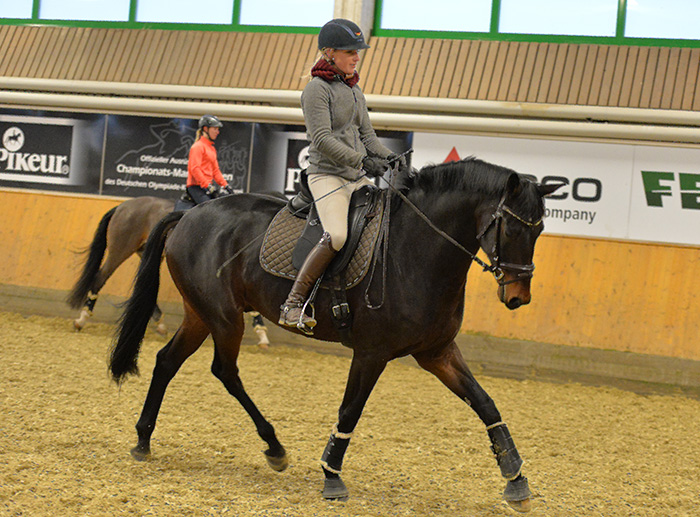
So we don’t take advantage of that quality?
“Well we do because they offer so much. Look at that girl in the arena again, she has just started trotting, the tail is loose, he puts himself in such a frame, she can just let him a bit rounder and longer and natural at the beginning – you don’t have to flex the head downwards – the wither is already up as the horse starts to trot, you don’t have to do anything.”
Has it become two streams – on one, these beautiful young horses but they are never anything but young horse stars, and the other, not so fashionable looking, but they make Grand Prix? We get a lot more De Niro Grand Prix horses than we have Sandro Hits…
“The Grand Prix horse is always made, it’s not just there, it doesn’t come from the stallion like a Grand Prix horse, it always needs the right trainer / rider who brings it there. The majority of people, or clients, who buy horses in auctions or wherever, they like to see it already in a young horse, very pretty, big, black horses, but still they need good training, good basics and a good education, that they get there. If the horse is athletic and if the horse has a good mind, willing to work, with good rideability, it doesn’t matter who the sire or the dam is, the Grand Prix horse is always made.”
“Of course we see a number of horses that never get there, even though they have the talent. I think the breeders have understood that we also need athletic horses that are able to absorb the work. Not to just have big steps in the beginning for two or three years, then the big steps have disappeared and there is nothing left.”
Sometimes when we look at the horses that have won a lot, like Valegro, this is not such a long beautiful horse, it is more compact…
“Yes, athletic.”
And the breeders were perhaps getting away from that model trying to breed more beauty, more elegance…
“Still the super beautiful model will be a best seller, but probably we need a little more substance. Valegro was perhaps not the best looking horse as a young horse, but when you see his conformation, the horse is a super correct built horse. The angles are fine, not too big, not too small, not too long, not too short, the angle of the shoulder and the croup and the hocks, uphill – all that together with the energy and the power from the hind legs, he was nearly the perfect built horse. There really is no rule, they come in all shapes and sometimes it is incredible what they can do. Weihegold, she is also a very correctly built horse, but completely different. There is not this immense phenomenal trot, but she has the best hind leg of all horses. At the moment, it is just the best hind leg, it can push and it can carry without any effort.”
Can we talk a little about how you structure your training system?
“We start with the pony riders, with the kids. So now we have trainers for riders under 14, trainers for the pony riders under 16.”
“Our head trainer for ponies, Cornelia Endres, she has been winning for the past fifteen, twenty years. She has the most newcomers, of course, because there are new kids every year.”
Does she have an Isabell?
“Impossible. Maybe she has an Isabell but only for two years, not forever! She has new kids every year, and she is paid from here (Warendorf) to go traveling through the country to the regional competitions, where the pony riders have already been pre-selected from other competitions. She gets them when they are 12, 13, 14 and starts working with them. Regularly they have clinics here, that’s for all the groups, the ponies and the junior and young riders.”
We have the pushy mothers with their pushed children and once they turn eighteen these young rider superstars discover life and disappear, and often the riders that are better in open competition were not young stars, does that happen here as well?
“In some cases, that is the case, but we try to keep the very talented ones. The ones that win championships and are very talented and willing to work, we try to keep them and give them possibilities. Some are very wealthy and they do it anyway, but for example, this girl in the arena with her young horse, she was an under 21 champion and a European champion, she is now riding in the under 25 level, so little Grand Prix and she was on the team this year for the European under 25 Championships, in the winning team. She is now here in our prospective group, one of three girls who are living and working here at the DOKR. I train them, and also Sebastian Heinze, he’s the trainer for the under 25 group. Here’s a second one, she is also from this group, she was also a member of an under 21 team. She is stationed here at the Army training facility just down the road and rides here full-time. They can also make their apprenticeship here with us.”
How many young riders get to come to Warendorf and work with you guys?
“Three or four in this group, over the year, 15, 20. The young ones don’t only work with me. They work with Hans-Heinrich Meyer zu Strohen, with Ollie Oelrich and Sebastian Heinze.”
Monica especially likes the space around the DOKR, as anyone who has attended the Bundeschampionate would know, there are plenty of open fields to get out and hack…
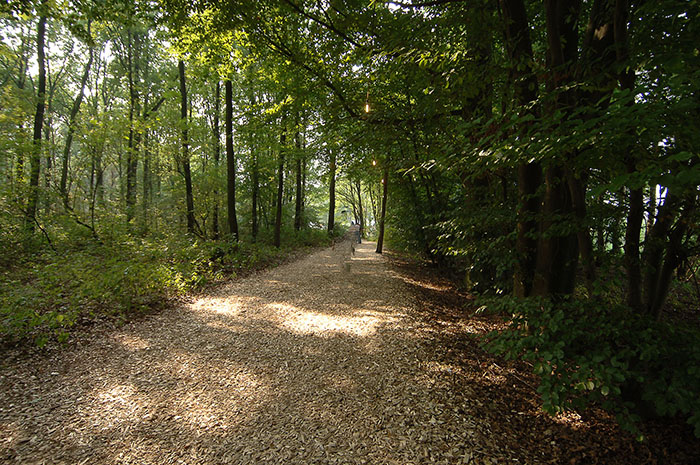
“We can use all the competition spaces, you can ride for hours out there. We all do it, we do it together. One of the perspective group dressage riders, Clare, even jumps with her horses. She takes her horse to the jumping lessons.”
You like that, that they jump?
“It’s perfect, if they are happy to do it, do it, go – it’s good for their balance, it’s good for the horses’ minds, galloping and round and happy. And the trainer of the jumpers, he doesn’t say anything different to what I say. When you see him in this indoor, training his jumper kids on the flat, he says what we all say.”
What about the adult riders, the ones who have come through young riders, what is on offer for them?
“We have cadres, different lists. So we have the Olympic cadre, that’s the A team, then we have the perspective team, it used to be called the B team, then there is an under 25 list, and all those riders get free training from us. They come here, or I can go to them. Also there is Jonny, we split this between us. Then they get support at the competitions and everything.”
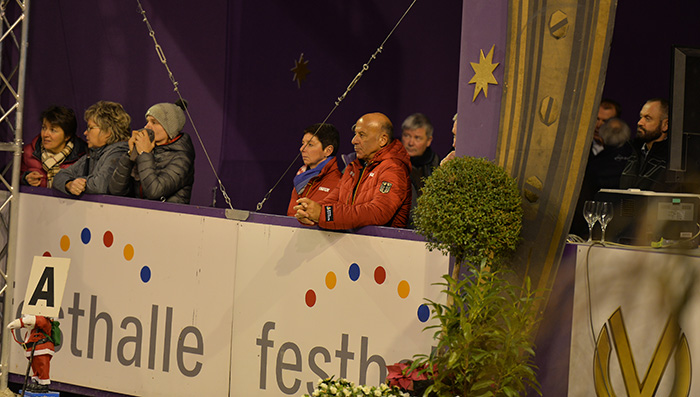
Monica and Jonny Hilberath watching a team member at Frankfurt
Are you happy with the progress of the young riders coming through your system?
“I think the level in under 25 is growing, and it’s great that we how have this under 25 European Championship because there were 38 competitors this season in our under 25 competition, last year 25 . There is obviously a need for these championships so these riders don’t have to go up against the open Grand Prix competitors. They probably cannot compete yet with an Isabell or Carl and Dorothee. But they can get experience at these nice shows, so we have an under 25 Nations Cup at Aachen and it is not only that they ride there, and compete there for the first time, but they watch everybody else during the week. This came from our system, we have now had for 16/17 years, the Piaff prize, this is the best we have for these under 25 riders, they compete against each other in a group.”
It helps that your young riders see good riding?
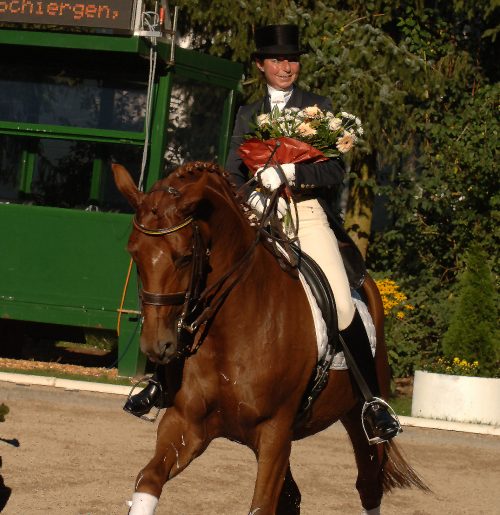
Monica and Whisper – the coach has been there, done that…
“Yes, when you have a strong team, then the competition within the team makes everybody better. We had that when we were successful in the 90’s, with Isabell, and Nicole and Klaus and later with Ulla, we had a strong team, you get better and better because nobody wants to be the idiot, you have to do well.”
Have you got another Isabell coming on line?
“You can’t say another one like her, but I think we have good riders. There is a lot that has to come together, and for sure, there are the horses that you have to have. For example, Bianca Nowag, she is very talented and doing well but it needs a lot of experience, a lot of work and it needs horses…”
Is this another problem – not everyone has a Madeline Winter-Schulze?
“There is a problem, not every body can afford top horses. Sönke Rothenberger is one example, he is a top class rider, very professional and right now he is flying high – this top class horse, Cosmo, one of the best in the world. If you are lucky, if you have a horse like that, then you can show your talent.”
The Federation doesn’t buy horses for promising riders?
“No, impossible. There are some sponsors that give a little bit, maybe to hold a horse, if an owner or breeder want to keep the horse, we can help, but we are not able to buy horses for real money. Owners or breeders need to have the passion to want to keep a horse and have the possibility to see it in big competition… and have a lot of patience to get there. If you have a good young horse that you want to give to a good up-and-coming rider, then you have to have patience and wait until maybe it becomes an international horse.”
And that’s a big ‘maybe’…
“Sure. Isabell has a lot of young horses with the hope that maybe they become international Grand Prix horses, but you never know because it takes five, six years and maybe the horse doesn’t get there, maybe it’s sick or it doesn’t like to do it, too hard to it, or whatever. And this you only discover from training the horse, you cannot tell right from the beginning, yeah this one will be great. Only a few get there.”
You talk about the team of coaches, you, Jonny, Sebastian, Hans-Heinrich, are you all exactly the same in your training philosophies?
“I think it works very well within this group because we all have the same attitude or philosophy of how it should be, and we stick to our guidelines. Of course everybody has a different pronunciation, but it stays within the system. I’m the responsible one. When I see how the younger riders ride, I see that everything is going the correct way.”
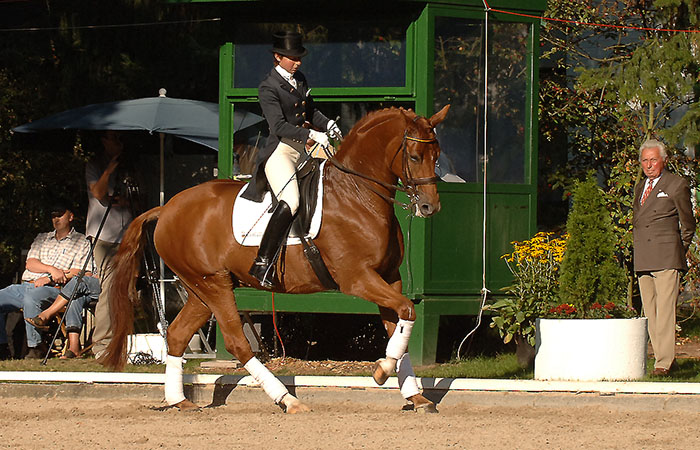
Eyes on the ground for Monica, her father Georg
And there really is only one correct way…
“I’ve been educated that way, always regarding our guidelines – I don’t need to look in that book any more, because I grew up like this. When I started, I hadn’t read that book, but later, when I did, I said, but that’s what we are doing. That’s what I was always told. Surprise! It comes from somewhere. That’s what I said, the horses are better, but it is still a horse with four legs, a head and a tail. You can’t turn it around and invent something completely different. If it didn’t work we would make changes, but I think it works quite well. Of course you have to find individual ways, and the key to every horse, but within our system and within our guidelines.”
What is the future for you, and German dressage? More of the same, it just keeps rolling along…
“Well if it rolls this way, I’m quite happy. For sure we want to make it with a lot of quality, and medals, but also with good riding, nice riding with happy, well-trained, athletic horses. I mean they are happy when they are in the field, but we to do sport, we want to get better and to be consistent. We want to stay consistently on a high level, with athletic horses, that are treated well.”
next we meet Dietrich Plewa, judge
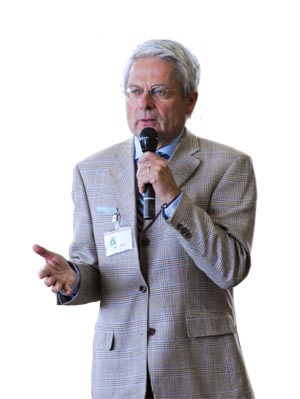
The Judge – Dietrich Plewa
Germany is also blessed with a large number of highly qualified judges, and because of the high prestige of being a judge, there is a queue of hopefuls gaining experience and hoping to break into the top ranks. Dietrich Plewa was a successful Grand Prix dressage rider, now he is a thoughtful five-star judge.
What would you see as the major factors that have contributed to Germany’s dressage strength?
“I think the major factor is the quality of breeding, and the tradition of a riding culture.”
Where does that tradition come from? It is easy in Australia to keep a horse, but it is quite difficult in the German climate…
“I think there is a relationship between horses used as working horses, and also to the cavalry horses of the military. The base of riding in Germany was built on the tradition of military riding, and it’s this tradition and its culture that still makes riding successful in Germany.
France had a similar background, but disappeared as a modern dressage nation – how much of the German experience has to do with exceptional teachers like Steinbrecht…
“There were a number of individuals making progress in the education of horses, Steinbrecht, later on Waitjen, Müseler, many German horse people were really interested to learn from the horses, not to educate them to show special things – like circus – but dressage in Germany was from the start, to work together with the horse. Educating the horse to give his best, to the best of his capabilities.”
Do the judges in Germany work with the dressage administration – is this the way our dressage should go if we are to be successful?
“A little bit, but it is more the trainers that we work with than the administrators. The trainers talk with the judges.”
I have seen classes in Germany when two horses ride at the same time in front of the judge and at the end of the test, the judge talks directly to them about the test. I get the feeling in Germany that there is a more cooperative relationship between riders and judges…
“That is true in the lower classes, sometimes it is four riders in at once, and the judges are educating the riders. Next to the rider is standing the trainer, listening to what the judge has to say, and they try to improve, using the suggestions from the judge.”
We also saw here in Frankfurt another of the great strengths of German dressage, the passionate involvement of a very knowledgeable crowd of spectators…
“Three weeks ago I was in Stockholm and I was really impressed by the knowledge of the crowd, and there were so many spectators, watching from nine in the morning until five in the afternoon. I think Sweden is on a good way to make dressage riding popular. Okay in Germany, as a result of the German success for many years, we have many people who are involved in educating horses, in riding and training, and we have many interested people.”
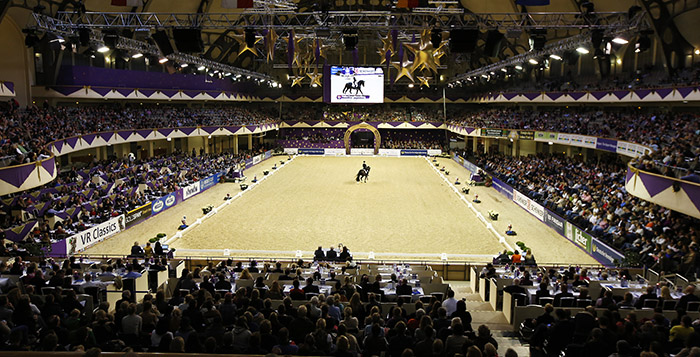
The standard here at Frankfurt in the Louisdor and the Nürnberger Burg-Pokal – the classes for the younger horses – was so high, and the horses were fresh and attractive…
“I completely agree. The Nürnberger Burg-Pokal for the horses from seven to nine years old, and the Louisdor Cup for the Grand Prix horses from eight to ten years, that is such a good way to lead them up to international Grand Prix. The interesting thing for the spectators is that there are many new horses, not always the same famous combinations, and that makes it interesting for the spectators.”
next we talk to Hubertus Schmidt
The Riders – Hubertus Schmidt
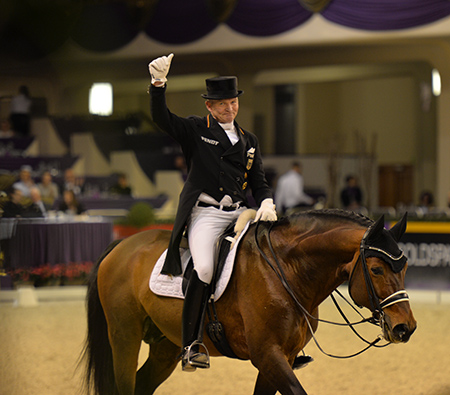
Hubertus Schmidt is another of the consummate professionals that contribute so much to German dressage. Hubertus has always been an elegant rider, in harmony with his horses, and now it seems his time is coming.
What do you think has been the strength of German dressage?
“There are several reasons. First we have very good breeding in Germany – now Denmark and The Netherlands, they also have good breeding, but it started here in Germany and we have a lot of good horses. The next is really our training system – and also our professionals. For example, every year I have three working pupils learning with me, learning for three years to be a Bereiter, and then you make your Master. There is also a system for the horses – like the Nürnberger Burg-Pokal for young horses, then the Louisdor for the young Grand Prix horses – for a long time the step from Prix St Georges to Grand Prix was so big. And now with these classes, you keep the owners happy, and you don’t have to start immediately after St Georges with the top Grand Prix class. So in the Louisdor, the eight to ten year old horses compete in their own group.”
“So there are a number of reasons: breeding, the good training system and the good trainers we have. It’s no surprise to find Jan Bemelmans in France, Klaus Balkenhol in America, Jo Hinnemann in Canada – there are so many German trainers all around the world. And it good for dressage, for a while Germany won all the team gold medals but it is good that England could win. It is good that dressage all over the world comes more and more together.”
Conclusion…
If you are still with me after so many words, congratulations, and I hope you enjoyed the journey. It may seem odd, an Australian setting out to write about a German sport, and a very Germanic German sport at that, but the truth is the people directly involved often miss what is distinctive about the system they are working in – that’s their world, that’s how it has always been.
Coming from the other side of the world, where dressage really only began in the 1950’s, and where it remains a total mystery to about 99% of the population, Germany is a revelation. I hope that I have recorded some of the important moments, and at the same time, provide food for thought for those seeking to grow the infant dressage plant in their countries. Most of all, I hope I have recorded some of the great riders, trainers, breeders, and the horses and that plays some small part in keeping alive the classical tradition…
- Christopher Hector
Appendix: The Facts and Figures
The German Equestrian Federation (FN) was, established in 1905. Eight years later, the German Olympic Committee for Equestrian Sports (DOKR) was founded, with Dr Gustav Rau as its Secretary General, as a reaction to the unsuccessful results of the German riders at the Olympic Games 1912 in Stockholm. Today, the DOKR remains responsible for sending Athletes to international events and Championships.
In 1968, a general overhaul of all pre-existing German equestrian associations brought the current structure of German equestrian activities. The majority of associations and organisations merged into the German Equestrian Federation (FN).
Let’s look at the current situation in Germany:
People and Horses
- For a study conducted by the Allensbach Media Market Analysis (AWA) in 2016, around 14 million interviewed persons replied they had an interest in horse riding.
Around 4 million people are even particularly interested in this sport. Only persons aged 14 or over were asked, however. Concerning the number of riders in Germany, the study revealed that 3.89 million people refer to themselves as riders. 1.25 million ride intensively. 78 % of them are female. Furthermore, there are about 900,000 horse owners in Germany.
- Based on various studies and figures e. g. from the IPSOS study, the Chambers of Agriculture and the Allensbach Media Market Analysis, the German NF estimates that the population of horses in Germany amounts to 1.3 million.
Organised Horse Sport
(All of the subsequent figures relate to the year 2016.)
- The German Equestrian Federation (Fédération Equestre Nationale, FN), the overall national association of equestrian sports, is the world’s largest horse sport association. Within the German Olympic Sports Confederation (DOSB), the German National Federation with its 690,995 members is on rank 8 (previous year: 689,941). This means a slight increase of 0.15 %.
- Horse Sport is very popular with females. Around 76 % (536,123) of the NF members are girls and women. With 154,872 members, the male part is much smaller.
- The regional association of Westphalia takes the lead in terms of membership numbers (99,215), followed by Baden Württemberg (98,151), Bavaria (93,554), Hanover (82,702), Hesse (69,434) and Rhineland (60,150). Adding up Westphalia and Rhineland, Northrhine-Westphalia would have 159,365 members while Lower Saxony (Hanover/Bremen and Weser-Ems) would count 132,187 members in their riding clubs.
Organisational Structure of the German NF
- Deutsche Reiterliche Vereinigung (FN) is the umbrella organisation for 17 regional horse sport organisations with 7,569 riding and driving clubs. The breeding sector comprises 25 German studbooks whose focus is laid on breeding the German Warmblood Horse.
- Directly affiliated to FN (or its member organisations) are also 3,830 commercial horse centres as well as 58,423 Personal Members.
- Further member organisations are Deutsches Olympiade-Komitee für Reiterei (DOKR/ German Olympic Committee for Equestrian Sport), Deutscher Reiter- und Fahrer-Verband (German Riders‘ and Drivers‘ Association), Deutsche Richtervereinigung für Pferdeleistungsprüfungen (German Judges‘ Association)
Competition Sport
In the year 2016,
- 3,539 horse shows (previous year: 3,568) with 68,726 competitions (previous year: 69,961) and 1,463,977 starts (previous year: 1,505,060) were run. Prize-money was distributed to a tune of EUR 31,996,514 (previous year: EUR 33,824,781).
- FN issued 82,877 annual licences entitling riders to compete in horse shows (previous year: 82,951) including 1,542 licences for foreign riders competing in national events in Germany (previous year: 1,506). Moreover, ‘give it a try’ licences numbered 7,535 adolescents and adults to make their first steps into competition sport (previous year: 7,396).
- FN issued licences for 141,240 competition horses and ponies (previous year: 142,046) and 2,593 FEI passports for horses competing internationally (previous year: 2,472). The above figure includes the registration of 24,006 first-time competition horses and ponies (previous year: 24,799).
- 57 % of all competition horses were aged between five and ten, 26 % of them between eleven and fifteen. 8 % of the horses were three, another 8 % four years old. 9 % of the horses were aged sixteen or over.
Horse Breeding
German studbooks have a significant share in the success of German horse sport.
- In 2016, German studbooks registered 3,185 riding horse sires (previous year: 3,400), 53,151 riding horse brood mares (previous year: 54,182) and 24,269 riding horse foals (previous year: 24,269). The number of coverings of warmblood mares has risen slightly to 31,195 compared to 30,502 in 2015. This is a plus of 2.27 %.
- Summing up all horse and pony breeds of the 25 studbooks affiliated to FN, from Akhal-Teke to Tinker, the following stock of breeding animals was reported in 2016:
Horses: 7,816 stallions (previous year: 8,121), 81,075 brood mares (previous year: 81,990) and 35,718 foals (previous year: 34,946).
- Ponies and small horses of all breeds: 3,483 stallions (previous year: 3,510), 19,779 brood mares (previous year: 20,052) and 8,122 foals (previous year: 8,017).
- 190 riding horse stallions passed the two-weeks‘ performance test for stallions in 2016 (previous year: 30-day performance test and 169 examined riding horse stallions). 147 stallions underwent the 50-day performance test (previous year: 70- day performance test and 111 examined stallions).
2,951 brood mares (previous year: 2,914) gave proof of their performance capability in stationary and field tests.
- At the Olympic Games in Rio, 70 out of 223 entered horses – including reserve horses – had German breeding. Thus nearly 30 % of all horses entered in Dressage, Jumping and Eventing were of German origin. In Jumping, 24 of the total 89 horses were of German breed (27 %). 26 of 69 entered Dressage horses had a German pedigree (37.7 %). There was also an increase in Eventing. 20 out of 75 horses are assignable to German studbooks (26.7 %) while in Hong Kong in 2008, this was the case for only 4 of 73 horses. With 5 gold, 5 silver and 7 bronze medals, horses of German breeding won 17 of 45 possible medals (37.8 %). 9 of these 17 medals were won in Dressage and 6 in Eventing.
Horses – The Economic Factor
- For more than 10,000 companies, craftsman’s establishments and service providers in Germany, the horse is their direct or indirect main subject of business activity.
- The annual turnover of German horse industry is estimated at EUR 6.7 bn. Expenditures for keeping a horse have a share of 39 % (EUR 2.6 bn). 61 % (EUR 4.1 bn) of the total turnover is allotted to retail and service. Once again, Thomas Hartwig has an update: “Last year I made a scientific study for the German FN and I found out that the turnover has a level of nearly 9 billion and there are more than 1.3 million horses and ponies in Germany.
- At the 2016 horse auctions hosted by German studbooks, 909 riding horses were sold at an average price of EUR 23,569. The total turnover of the auctions was EUR 21,424,476 (previous year: 884 riding horses, average price of EUR 22,112, total turnover of EUR 19,547,307). Furthermore, the studbooks auctioned around 1,510 breeding horses and foals as well as ponies and heavy draught horses. Thus 2,419 horses and ponies changed ownership on studbook auction sales.
Breeding a dressage horse? There’s a range of top European stallions available here: www.ihb.com.au
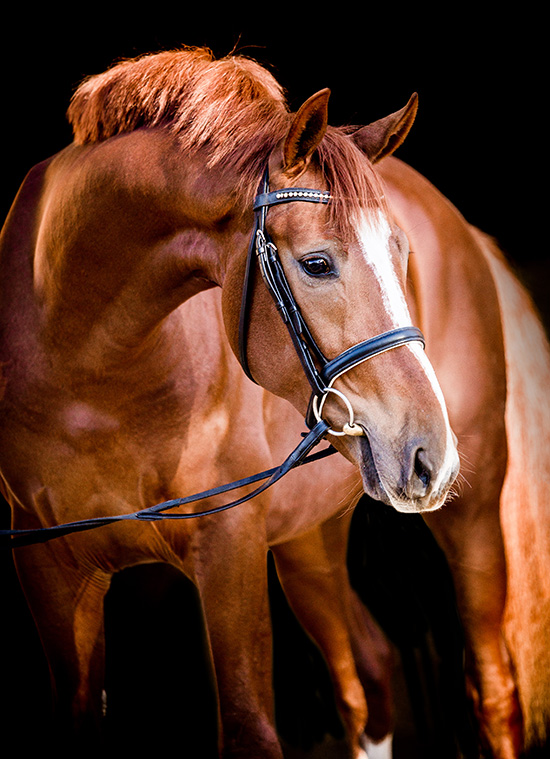
Dohnanyi



